Abstract
Turkey has a large agricultural area and produces 55–60 million tons of biomass waste/year. This study aimed to obtain bio-briquettes from three types of dried greenhouse wastes and to determine their strength parameters. A prototype of a mobile briquetting machine driven by power take-off (PTO), with hydraulic pistons, and comprising a shredder and grinding or crushing unit with a briquetting pressure in the range of 0–190 MPa, was used. The physical parameters of the obtained briquettes were determined, including density, tumbler and shatter resistance, compression resistance, water intake capacity, and resistance to moisture-humidity. The results of physical and mechanical tests showed that the briquettes are of an extremely high quality. The maximum density, shatter and tumbler resistance were 1143.52 kg·m−3, 99.24% in pepper plant waste, and 98.52% in eggplant plant waste, respectively. Based on the analysis of compression tests obtained under 190 MPa (maximum compaction force of 450 kN), the maximum compression force, compression stress, and specific compression force were found in briquettes made from tomato plant wastes (3315 N, 69.43 N·mm−2, 40.09 N·mm−1, respectively). Overall, the results and variables affecting the strength parameters showed that greenhouse waste biomass is an excellent feedstock for the production of high quality bio-briquettes. The valorization of briquetted greenhouse waste with the proposed prototype contributes to the sustainability of the environment and to a reduction in energy costs for farmers.
1. Introduction
Currently, the primary energy sources are fossil fuels, such as coal, crude oil, natural gas, and nuclear energy, which account for about 80% of global annual energy consumption [1]. These energy sources are expected to run out in the next 40 to 50 years. In addition to the fact that they are polluting, these fossil sources cannot easily be replaced by natural means at a rate fast enough to keep up with consumption. Hence, it is imperative to find and use alternative energy sources. Renewable energy sources, derived from natural sources or processes that are constantly renewed, include wind energy, solar energy (thermal, photovoltaic, and concentrated), hydro energy, tidal energy, geothermal energy, ambient heat captured by heat pumps, and biomass. The search for alternative energy sources that can meet the needs of the world’s population, which are usually met by hydrocarbons, has shifted the research focus not only to new sources such as solar, hydro, or nuclear energy, but also to the reuse of waste materials from other processes such as feedstock for biomass applications. Biomass refers to any organic waste or material, and mainly plant waste is used for energy purposes [2].
Biomass is an abundant and a continuously available resource; it was the dominant source of energy long before fossil fuels, but in recent years it has been reintegrated into large-scale bioenergy supply [3]. Bioenergy is derived from a wide range of raw materials, including agricultural residues, dedicated energy crops, wood processing residues, algae, the organic fraction of municipal solid waste, and food waste.
Biomass is promoted as one of the few energy sources with a carbon footprint close to zero, because, although burning biomass generates CO2 emissions, during their growth the plants absorb CO2 from the atmosphere [4].
Direct conversion of biomass, such as combustion, and indirect conversion methods, such as pyrolysis, gasification, and liquefaction, are methods of obtaining compounds that can be used as fuels [5]. Biomass conversion techniques have become a rapidly growing branch of science, and a technology aimed at meeting ever-increasing energy demand while reducing CO2 emissions by 70–90% [6].
The use of biomass as feedstock for biofuels production is often seen as a way to bridge the growing gap between energy demand and supply, especially given the finite nature of non-renewable energy sources such as fossil fuels [7].
Biomass, which includes agricultural residues, accounts for about two-thirds of all potential renewable energy sources in Turkey [8], a country with vast agricultural production areas that offer enormous potential for renewable energy. Turkey’s energy consumption has increased rapidly due to its growing population and its status as a developing country.
Turkey is one of the most important greenhouse centers in the world. The total greenhouse area in Turkey is 77,210 ha, of which 7811 ha are under glass, and 69,399 ha are under plastic [9]. In Turkey, greenhouses are used for growing tomatoes, peppers, and eggplant. On a wet basis, the annual amount of biomass waste generated in greenhouses from the cultivation of tomatoes, peppers, and eggplant is about 1690 thousand tons, and on a dry basis, 253 thousand tons [10]. Although greenhouses in Turkey produce huge amounts of agricultural waste every year, it is burned, disposed of from the greenhouses, or ground into the greenhouse soil [11].
Biomass waste, especially agricultural residues, is a durable feedstock for biofuels, with a minimal impact on food security [12]. However, its high moisture content and low bulk density are the main drawbacks in conversion technologies [13,14]. However, biomass properties can be improved by increasing its density, which can facilitate storage and transportation as well as the ability or capacity to generate energy by applying a modest amount of energy [7].
Bio-briquetting consists of the densification or compaction of solid biomass (discarded or secondary and referred to as waste in industrial and agricultural production processes) under high pressure [15], and high temperature, with or without binders [16]. Bio-briquetting is one of the most efficient methods to valorize biomass waste, by which a low-cost, environmentally friendly, renewable, and certified solid biofuel called bio-briquette is obtained. Compared to the raw biomass, the bio-briquettes are characterized by increased bulk density, uniform shapes (usually cylindrical or rectangular) and sizes (diameter between 25 and 100 mm and length between 10 and 400 mm) [17], low moisture content, higher energy content, and improved combustion characteristics [18,19]. This method of biomass valorization can also drastically reduce the storage and transport costs of biomass waste, and contributes to environmental sustainability because it avoids the decomposition of biomass waste and the generation of greenhouse gases. The waste generated from briquetting is further recycled into the bioeconomy, reducing Turkey’s dependence on imported energy.
Bio-briquettes are usually used for domestic heating, and co-firing with coal in heat and power generation centers or thermal power plants. In addition, the briquettes obtained by agricultural enterprises from their greenhouse waste are high in quality and suitable for use instead of fossil fuels in greenhouse heating.
As a result of the literature studies, it was found that the grinding and crushing process required for briquetting biomass is carried out in two different machines, and the ground material is then processed into briquettes using immobile, screw, piston, or hydraulic press technologies with an electric motor.
Hazelnut residues [1], a mixture of rice husks and pine sawdust [2], vineyard wastes [16], tea waste [20,21], wood processing residues (sawdust, mulch and wood crisps) [22], woody and herbaceous biomass blends [23], lignite mixed with woody waste [24], sawdust and rapeseed cake [25], palm kernel fibers [26], cotton and sesame stalks [27], various greenhouse plant wastes [28], straws, reed and hemp stalks [29], cotton stalks [30], reed species as energy crops [31], sunflower stalks [32], various energy crops (Salix viminalis, Miscanthus sinensis, Rosa multiflora, Polygonum sachalinensis, Helianthus tuberosus, Sida hermaphrodita and Spartina pectinata) [33], kiwi cuttings [34], corn stalks [35], sugarcane bagasse and straws [36], were previously briquetted in hydraulic presses, piston or conical screw presses with electric motor drive under different briquetting pressures, particle sizes or moisture contents, in order to valorize biomass waste as solid biofuels and contribute to environmental sustainability.
The objective of this study was to bio-briquette the biomass waste of pepper, tomato, and eggplant crops grown in greenhouse, using a prototype of power take-off (PTO)-driven mobile hydraulic piston briquetting machine, and to evaluate the quality of the bio-briquettes as solid fuel. The processes of shredding, grinding, and briquetting were carried out on site in a single machine without having to transport the dried waste from place to place.
2. Materials and Methods
2.1. Bio-Briquetting Procedures
The experimental tests were conducted at Akdeniz University, Vocational School of Technical Sciences, Department of Machinery, and Ondokuz Mayıs University, Faculty of Agriculture, Department of Agricultural Machinery, respectively.
The harvesting waste of peppers, tomatoes, and eggplant grown in greenhouses was used in this study as biomass feedstock. The moisture content of pepper, tomato and eggplant wastes was reduced between 7% and 9%, by drying in the sun under normal conditions as prescribed in the standard EN 14774-1 [37]. The dried wastes were briquetted using a mobile, hydraulic, PTO-driven piston briquetting machine which contains a crusher and grinder with a briquetting range of 0–190 MPa, developed as a prototype (Figure 1 and Figure 2). No binder was used during the briquetting process.
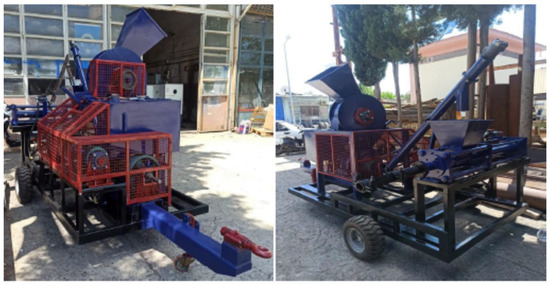
Figure 1.
Prototype of mobile briquetting machine.
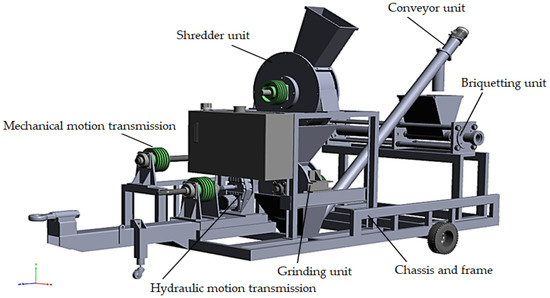
Figure 2.
Prototype mobile briquetting machine driven by PTO, with hydraulic piston.
The dried wastes were initially shredded in the shredding unit of the prototype machine, which consists of 40 hammers made of hardox steel and 16 counter blades, which takes its movement from the tractor PTO with the belt-pulley system and rotate at a speed of 2550 rpm. The drawings of the shredder unit, obtained in SolidWorks, are presented in Figure 3, and the isometric assembly drawings are presented in Figure 4.
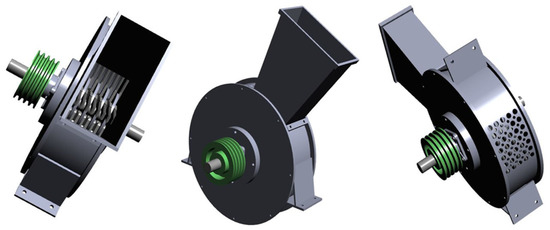
Figure 3.
SolidWorks drawings of the shredder unit.
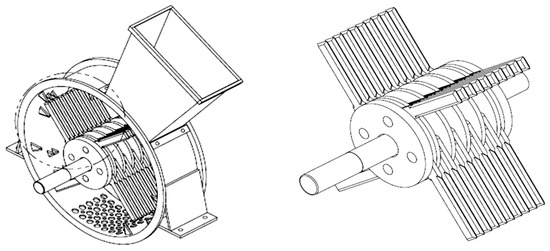
Figure 4.
Shredder unit assembly drawings.
Then, the shredded material taken from the shredding unit to the grinding unit was brought to the required piece size for briquetting in the grinding unit on the prototype machine, which consists of 24 hammers made of hardox steel and 58 counter blades rotating at 2200 rpm. The SolidWorks drawings of the grinding unit are given in Figure 5, and the isometric assembly drawings are seen in Figure 6.
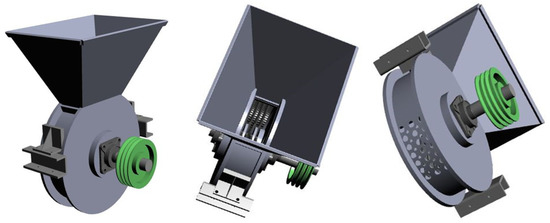
Figure 5.
SolidWorks drawings of the grinding unit.
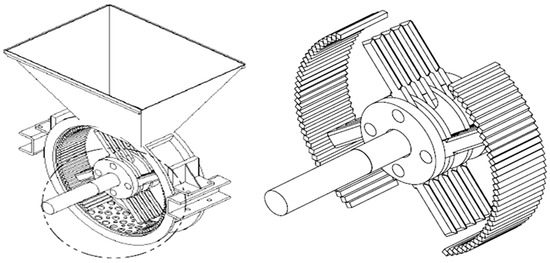
Figure 6.
Drawings of the grinding unit assembly.
The properties of greenhouse wastes (pepper, tomato, and eggplant) used in briquetting experiments are given in Table 1.

Table 1.
Properties of ground pepper, tomato and eggplant waste used in the experiments.
After obtaining particles of the requisite sizes (0–2 mm), moisture contents were determined again, and the particles were briquetted using the prototype briquetting machine with hydraulic piston operated by PTO (Figure 7).
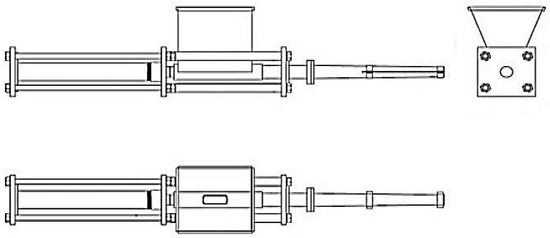
Figure 7.
Hydraulic piston briquetting unit.
The compaction pressure of the hydraulic piston press can be adjusted from 0 to 190 MPa. The conical die has an inlet diameter of 60 mm, an outlet diameter of 55 mm, and a piston diameter of 54.5 mm. To prevent jamming in the die during the briquetting process, the conical die was supported by clamps with spring nuts and bent during pressing if necessary.
Briquetting of greenhouse plant waste was carried out using the maximum compaction pressure of 190 MPa (maximum compaction force of 450 kN). The bio-briquettes obtained from greenhouse waste had a diameter of 55 mm and lengths between 45 and 50 mm (Figure 8).

Figure 8.
Bio-briquettes obtained from greenhouse wastes.
2.2. Experimental Measurements of Bio-Briquettes Quality
Measurements were carried out in accordance with European standard EN 13183-1 [38]. Moisture content (MC) was measured by drying 20 randomly selected briquette samples, for 24 h at 105 °C in a laboratory dryer. The samples were weighed on a laboratory balance with an accuracy of 0.001 g.
Moisture content is defined as the mass fraction of water contained in the samples according to the formula [39]:
where m0 is mass of initial weight of sample (g), and m1 is mass of final weight of sample (g).
The individual bio-briquette density was measured using an electronic caliper to determine length and diameter in two perpendicular directions (0.01 mm). On laboratory scales, the mass of individual briquettes (0.001 g) was determined. The following formula was used to calculate the density of bio-briquettes [38]:
where m is the mass of an individual briquette (kg), d is average diameter of briquette (m), and h is briquette length (m).
Bio-briquette resistance to breakage by impact (Tumbler index) and after falling (Shatter index) were assessed using ASTM D 440-86 [40] and ASAE S269.4 [41] standards, respectively.
In the Tumbler resistance test, five briquette samples were weighed and placed in the tester. The bio-briquettes were then tumbled for 3 min at 40 rpm. After the completion of the rotation process, briquettes were withdrawn from the tester and weighed again. Tumbler resistance was evaluated as a percentage of weight loss that occurred during the testing (Figure 9).
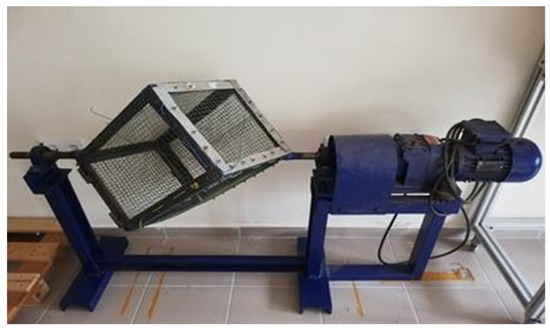
Figure 9.
Tumbler test.
Individual bio-briquettes were dropped 10 times from a height of 1 m onto a concrete floor in the shatter resistance test. Before and after the test, each briquette was weighed. Shatter resistance was determined as a percentage based on how much weight was lost during the dropping test. During the shatter and tumbler resistance tests, the broken pieces were screened with a 20 mm sieve, and the remaining pieces on the sieve were not considered to be lost [42].
The compression test does not correspond to any technical standard that must be followed. It was revealed on the basis of a previous scientific survey that referred to the mechanical properties of pressed materials [43]. The methodology described here was used to determine the hardness of the examined briquette samples, which influences their potential damage in transportation and storage. Compression tests of bio-briquette were carried out in line with ASTM E9-89 [44], with some parts of EN12504-1 [45] taken into consideration. A universal testing machine (LLOYD LRK Plus, with force capacity of 5000 N, minimum load resolution of 0.001 N, and data sampling rate of 8 kHz) consisting of two compressing plates was used. The bio-briquette sample was pressed between two plates of the testing equipment at a speed of 20 mm·min−1.
The applied compression force increased at a constant rate and continued until the bio-briquette broke, and the application forces were transferred to the computer during the test. The compression resistance of the bio-briquettes was calculated as N, and the specific compression resistance of the bio-briquettes (in N·mm−1) was calculated by dividing the pressure resistance to the briquette length [31,46].
Immersion tests have long been used to assess water intake resistance. Each bio-briquette was submerged for 30 seconds in water at 27 °C, and the water resistance of the briquettes was measured as a percentage based on the weight gain. Elongation, swelling, and the time it took for each briquette to totally disintegrate were also recorded [47].
Bio-briquettes were stored in a room with a temperature of 20 °C and a humidity of 50% for 21 days for the equivalent humidity content (humidity resistance) test. Before and after the test, each briquette was weighed. Depending on the weight increase occurring during the storage, humidity resistance was determined as a percentage [11].
All bio-briquettes were maintained for 7 days at a temperature of 20 °C and a relative humidity of 50% to guarantee that they were stable before the test. All tests performed to determine the quality characteristics of the briquettes were performed with three replications, and the arithmetic average of the obtained results was taken and analyzed for variance, and each test was performed on 50 randomly selected briquette samples.
This study analyzed the quality parameters of briquettes formed from greenhouse waste using briquetting pressures of 190 MPa, moisture contents of 7–9%, and particle sizes of 1–2 mm in order to assess their potential as solid biofuel made by the prototype briquette machine. Pressure was selected according to studies described by Zhang and Guo [48] and Krizan et al. [49].
All physical and mechanical properties of bio-briquettes were investigated by three replications with 20 determinations for each replication. Variance analysis was carried out on bio-briquettes from greenhouse waste (eggplant, tomato, and pepper) and the difference between the means was evaluated using the LSD test. Mean values were represented with the standard error.
3. Results
3.1. Moisture Content of Bio-Briquette Samples
The moisture content was determined immediately after briquetting the greenhouse waste. The data of the briquette moisture content obtained in the experiment are shown in Table 2. When the moisture content measured after briquetting is compared with the moisture content before briquetting, it is found that the moisture content of the samples decreases between 30 and 35%. Additionally, the heating of the material by the friction in the mold due to the pressure generated during briquetting effectively reduces the moisture content of the material.

Table 2.
Moisture contents of bio-briquettes (on average) obtained with the prototype machine.
As can be seen from Table 2, the moisture content of the briquettes was generally below 10%. The highest moisture content was found for the organic briquettes made from tomato plant waste (5.98%). The lowest moisture content was found for pepper plant waste (5.14%). The low moisture content of the briquettes obtained is important for the durability of the briquettes and the quality of the fuel.
There is no difference between the moisture content of the briquettes produced with the prototype briquetting machine and the moisture content of the briquettes produced with other different briquetting machines (piston press and conical screw with electric motor). There was a parallelism with the results obtained by Bilgin et al. [11], Kurklu and Bilgin [27], and Karaca [50], who found values of moisture content of the briquettes between 4.5 and 7%.
Grover and Mishra [51] recommended low moisture content (8–10%) for biomass materials to produce strong and crack-free briquettes. The briquettes produced in our study with the prototype were found to be very strong and crack-free, while their moisture content was in the range of 5–6%, so these conclusions can be confirmed. Moreover, the values of moisture content of the briquettes produced in the prototype briquetting machine show that the standard TSEN-ISO-17225-7 is below the class A products compared to the briquettes produced with other briquetting machines. It seems to be an acceptable good fuel in terms of briquette moisture.
3.2. Density of Bio-Briquette Samples
In general, the moisture content of biomass briquettes affects their density, as shown by other studies [52]. Density is a physical property that determines the quality of the briquette, and it is desirable that its value be as high as possible [35].
Table 3 shows the briquette density data from the experimental tests and the results of the analysis of variance. Considering that the raw material density of greenhouse waste ranges from 198.53 to 203.25 kg·m−3, one can see how much the volume of biomass is reduced by briquetting.

Table 3.
Density (average values) and variance analysis results of briquettes.
The density results showed that eggplant waste particles had better compaction capacity than tomato and pepper plant waste particles. It can be observed that the increase of the eggplant waste fraction affected the increase of the briquette’s density. The average densities of eggplant, tomato, and pepper plant waste briquettes were 1045.74 kg·m−3, 1150.18 kg·m−3, and 1143.52 kg·m−3, respectively.
The difference between the densities of briquettes obtained from greenhouse wastes was found to be statistically insignificant. In their studies, Karaca and Başçetinçelik [53], Gendek et al. [39] and Brunerová et al. [54] used a conical screw, piston, and hydraulic type press briquetting machine. They found the density of briquette as 1573.58 kg·m−3 for groundnut shell waste, 938.55 kg·m−3 for pinewood waste, and 1022.44 kg·m−3 for sugarcane bagasse, respectively.
The standard briquette density is expressed as 900 kg·m −3 and above according to EN14961-3 [55] standard and in another study, it was reported that the acceptable briquette density was between 1000 and 1400 kg·m−3 [51]. Therefore, based on these findings, briquette samples made by prototype machines from greenhouse waste were identified as suitable, as they meet the standard briquette density requirement.
3.3. Tumbler and Shatter Resistance Index
Tumbler and Shatter tests are used to determine the briquettes’ durability, as well as any losses that may occur during storage and transportation. These tests are carried out with specialized equipment, and the results are presented as a percentage, and a test value of 95% or more is normally considered satisfactory according to EN14961-3 [55]. The data on the Tumbler and Shatter resistance indexes of the briquettes obtained in the trials carried out according to the ASAE S269.4 [41] standard is shown in Table 4.

Table 4.
Tumbler-Shatter resistance indexes and variance analysis results of obtained briquettes (on average).
As seen in Table 4, the tumbler (93.61–98.52%) and shatter (90.73–99.24%) indexes were determined for the briquettes obtained with the prototype briquette machine, which shows that the briquettes’ durability is quite high. Although the Tumbler index of the briquettes obtained from pepper waste and the fragmentation index of the briquettes obtained from eggplant wastes were below 95%, no fragmentation was observed in the briquettes. The highest tumbler index was determined for eggplant waste bio-briquettes (98.52%), and a lower tumbler index was noted for pepper plant waste bio-briquettes (93.61%). As for the shatter index, the highest value was determined for pepper plant waste bio-briquettes (99.24%), and a lower value was noted for eggplant waste bio-briquettes (90.73%).
According to the results of the statistical analysis, the difference between the tumbler and shatter indexes of the briquettes obtained from different greenhouse wastes is statistically significant (p < 0.01). These findings reveal that briquettes made from various materials have varying levels of resistance.
The results obtained in Shatter and Tumbler resistance tests are evaluated between 0.5 and 1.0 (or 50 and 100%) [56]. The quality of the briquettes increases as the results approach a value of (1.0). According to this information, when Table 3 is examined, it can be said that the briquettes have a very strong structure since the shatter and tumbler resistance values of the briquettes obtained from tomato, pepper, and eggplant plant wastes are very close to one (1) value. Similar results were found with the tumbler and shatter index values of the briquettes obtained in other studies by Saeed et al. [7], Kaliyan and Morey [46], Brunerová et al. [54], Bazargan et al. [57], and Fengmin and Mingquan [58], respectively, using different briquetting machines and compression methods.
3.4. Compression Resistance Analysis of Bio-Briquettes
The compression resistance is a measure of the briquettes’ durability and strength against physical impacts. It is desired that the losses caused by stacking the briquettes during storage are at a minimum. The data of the briquette compression resistance obtained in the experiment are shown in Table 5.

Table 5.
Compression resistance and variance analysis results of obtained briquettes (on average).
According to Table 5, the maximum compression force, compression stress, and specific compression force were recorded in briquettes made from tomato plant wastes (3315 N, 69.43 N·mm−2, and 40.09 N·mm−1, respectively), whereas the lowest values were observed in briquettes made from eggplant waste (3090 N, 62.85 N·mm−2, and 35.68 N·mm−1, respectively).
Analyzing the results of the statistical analysis, the difference between the means of compression force and specific compressive force rates at briquette made by different greenhouse wastes was found to be significant (p < 0.05), and the difference between the means of compression stress rates at briquette made by different greenhouse waste was found to be significant too (p < 0.01). Similar results were found with the values obtained in studies with machines using other briquetting methods [59,60]. In addition, the overall assessment of the compression strength of the briquettes obtained with the prototype briquetting machine has proven satisfactory when compared with the briquette compression strength data obtained with other machines [61,62].
3.5. Compression Resistance Analysis of Bio-Briquettes
The resistance to moisture-humidity, water intake capacity, and their variance analysis results determined by immersing the briquettes obtained by the prototype machine in water are given in Table 6.

Table 6.
The resistance to moisture-humidity, water intake capacity, and variance analysis results of obtained briquettes. (on average).
In Table 6, according to the statistical analysis results, the difference between the water absorption resistance of the briquettes was significant (p < 0.05), and the difference between the equivalent moisture content was insignificant.
In previous studies it was stated that the water intake rate of the briquettes should not exceed 50% [56]. According to data in Table 6, it was determined that the percentage of increase for the briquettes produced with the prototype machine varied between 15.55 and 19.37 on average. The results prove that the briquettes obtained from the greenhouse wastes with the prototype machine are quite robust in terms of water intake resistance. Additionally, from Table 6, when the equivalent moisture contents of the briquettes were examined, there was not much change in the weight of the briquettes at the end of the 21st day. As a result, properly packed briquettes can be stored in good storage conditions for a long time without structural deterioration.
4. Conclusions
The main objective of the present study was to determine whether the prototype mobile briquette machine and waste from high production value vegetables such as tomatoes, eggplant, and peppers can be used to produce organic briquettes. The results obtained in the tests we carried out showed that the briquetted biomass with the briquette machine prototype has very good characteristics, so they can be used as solid biofuel. Additionally, in the production of the briquette, the briquetting machines working with an electric motor are generally used. As an energy dependent country, the use of electricity in the commercial production of biomass briquettes is controversial. However, using the mobile hydraulic briquetting machine, which takes its movement from the tractor, which is designed and manufactured, briquettes can be produced at much lower cost without the need for electricity consumption.
The durability and breaking strength of the briquettes were found to be quite high. The moisture content and particle size were found to be quite suitable for briquetting. The materials are compacted to a density about 5–6 times higher. Selected mechanical and physical characteristics of the briquettes, including compressive strength, longevity, and density, were assessed. The evaluated physico-mechanical characteristics of the generated briquettes were strongly impacted by modifications in the densification process parameter. The water resistance of the briquettes was found to be quite durable up to a certain period of time, and they were also found to have a longer shelf life than when they were first produced if well packaged. To be used as solid biofuels, briquettes must meet the requirements set out in the technical standard ISO 17225. Tests results showed that the briquettes obtained with the prototype briquetting machine meet these standards, and they are quite robust.
In general, all measurements and tests performed within the present research provided satisfactory results, and hence, the use of greenhouse wastes (tomato, pepper, and eggplant) and the prototype mobile briquette machine for the production of bio-briquettes is highly recommended. This study will be an exemplary application for the design studies of prototype machines that will use different briquetting techniques in the future.
Briquetting surplus agricultural waste for use as solid biofuel may help close the world’s energy gap and fight global warming. Additionally, by encouraging the development of new, agricultural-based enterprises, the use of agricultural waste as an alternative energy source can help to increase employment in agricultural communities. In addition to improving the quality and quantity of scientific data, further research is necessary to draw public attention to the energy potential of agricultural waste.
This research is also expected to contribute to a better understanding of waste management principles, briquetting technology, and the use of all types of biomass waste to create ecologically acceptable solid biofuels.
Author Contributions
Conceptualization, Ö.K., İ.Ü. and S.S.; methodology, Ö.K. and İ.Ü.; software, K.C.S.; validation, Ö.K., İ.Ü. and K.C.S.; formal analysis, N.U.; investigation, S.S.; resources, K.C.S.; data curation, İ.Ü. and S.S.; writing—original draft preparation, Ö.K. and İ.Ü.; writing—review and editing, Ö.K. and N.U.; visualization, N.U.; supervision, Ö.K. All authors have read and agreed to the published version of the manuscript.
Funding
This research was funded by The Scientific Research Projects Coordination Unit of Akdeniz University, project number: FBA-2017-1980. The APC was funded by University Politehnica of Bucharest, Romania, within the PubArt Program.
Data Availability Statement
Not applicable.
Acknowledgments
We are very grateful to the Akdeniz University Technical Sciences Vocational School technicians for their cooperation and effort in supporting the experiments.
Conflicts of Interest
The authors declare no conflict of interest.
References
- Krajnc, N. Wood Fuel Handbook; Food and Agriculture Organisation of the United Nations: Pristina, Republic of Kosovo, 2015. [Google Scholar]
- Niño, A.; Arzola, N.; Araque, O. Experimental study on the mechanical properties of biomass briquettes from a mixture of rice husk and pine sawdust. Energies 2020, 13, 1060. [Google Scholar] [CrossRef]
- Archer, S.A.; Steinberger-Wilckens, R. Systematic analysis of biomass derived fuels for fuel cells. Int. J. Hydrogen Energy 2018, 43, 23178–23192. [Google Scholar] [CrossRef]
- Catuti, M.; Milan, E.; Alessi, M.; Egenhofer, C. Biomass and Climate Neutrality. CEPS Policy Insights 2020, No 2020-19. Available online: https://www.ceps.eu/wp-content/uploads/2020/08/PI2020-19_Biomass-and-climate-neutrality.pdf (accessed on 2 November 2022).
- Bajwa, D.S.; Peterson, T.; Sharma, N.; Shojaeiarani, J.; Bajwa, S.G. A review of densified solid biomass for energy production. Renew. Sustain. Energy Rev. 2018, 96, 296–305. [Google Scholar] [CrossRef]
- Sohni, S.; Norulaini, N.A.N.; Hashim, R.; Khan, S.B.; Fadhullah, W.; Omar, A.K.M. Physicochemical characterization of Malaysian crop and agro-industrial biomass residues as renewable energy resources. Ind. Crop. Prod. 2018, 111, 642–650. [Google Scholar] [CrossRef]
- Voicea, I.; Vlăduţ, V.; Cârdei, P.; Matache, M.; Găgeanu, I.; Voicu, G.; Popescu, C.; Paraschiv, G.; Kabas, O. Compacting process and mathematical analysis of miscanthus briquettes expansion. In Proceeding of the 43rd International Symposium “Actual Tasks on Agricultural Engineering”, Opatija, Croaţia, 24–27 February 2015; Volume 43, pp. 667–676. [Google Scholar]
- Angın, D.; Şensöz, S. Effect of drifting gas (N2) flow on pyrolysis of safflower seed pulps and characterization of liquid product. Sci. Eng. J. Fırat Univ. 2006, 18, 535–542. [Google Scholar]
- Tüzel, Y.; Gül, A.; Öztekin, B.G.; Engindeniz, S.; Boyacı, F.; Duyar, H.; Cebeci, E.; Durdu, T. Türkiye’de örtüaltı yetiştiriciliği ve yeni gelişmeler. In Proceedings of the Türkiye Ziraat Mühendisliği IX.Teknik Kongresi, Ankara, Turkey, 13–17 October 2020. (In Turkish). [Google Scholar]
- Çerçioğlu, M. Sürdürülebilir atık yönetiminde sera atıklarının kompost olarak değerlendirilmesi. Bursa Uludağ Üniversitesi Ziraat Fakültesi Derg. 2019, 33, 167–178. (In Turkish) [Google Scholar]
- Bilgin, S.; Yılmaz, H.; Koçer, A. Briquetting of greenhouse pepper crop residues. Agric. Eng. Int. CIGR J. 2015, 185–192. Available online: https://www.researchgate.net/publication/282220438_Briquetting_of_greenhouse_pepper_crop_residues (accessed on 13 September 2022).
- Rosa, L.; Mazzotti, M. Potential for hydrogen production from sustainable biomass with carbon capture and storage. Renew. Sustain. Energy Rev. 2022, 157, 112123. [Google Scholar] [CrossRef]
- Găgeanu, I.; Cujbescu, D.; Persu, C.; Tudor, P.; Cârdei, P.; Matache, M.; Vlăduț, V.; Biriș, S.; Voicea, I.; Ungureanu, N. Influence of input and control parameters on the process of pelleting powdered biomass. Energies 2021, 14, 4104. [Google Scholar] [CrossRef]
- Ungureanu, N.; Vlăduț, V.; Voicu, G.; Dincă, M.; Zăbavă, B.Ș. Influence of biomass moisture content on pellet properties—A review. In Proceedings of the 17th International Conference Engineering for Rural Development, Jelgava, Latvia, 23−25 May 2018; Volume 17, pp. 1876–1883. [Google Scholar] [CrossRef]
- Vaish, S.; Kaur, G.; Sharma, N.K.; Gakkhar, N. Estimation for Potential of Agricultural Biomass Sources as Projections of Bio-Briquettes in Indian Context. Sustainability 2022, 14, 5077. [Google Scholar] [CrossRef]
- Senila, L.; Tenu, I.; Carlescu, P.; Scurtu, D.A.; Kovacs, E.; Senila, M.; Cadar, O.; Roman, M.; Dumitras, D.E.; Roman, C. Characterization of biobriquettes produced from vineyard wastes as a solid biofuel resource. Agriculture 2022, 12, 341. [Google Scholar] [CrossRef]
- Kpalo, S.; Zainuddin, M. Briquettes from agricultural residues; an alternative clean and sustainable fuel for domestic cooking in Nasarawa State, Nigeria. Energy Power 2020, 10, 40–47. [Google Scholar] [CrossRef]
- Saeed, A.; Harun, N.Y.; Bilad, M.; Afzal, M.; Parvez, A.; Roslan, F.; Rahim, S.A.; Vinayagam, V.; Afolabi, H. Moisture content impact on properties of briquette produced from rice husk waste. Sustainability 2021, 13, 3069. [Google Scholar] [CrossRef]
- Yang, W.; Lv, L.; Han, Y.; Li, Y.; Liu, H.; Zhu, Y.; Zhang, W.; Yang, H. Effect of densification on biomass combustion and particulate matter emission characteristics. Atmosphere 2022, 13, 1582. [Google Scholar] [CrossRef]
- Manyuchi, M.M.; Mbohwa, C.; Muzenda, E. Potential to produce biomass briquettes from tea waste. In Proceedings of the International Conference on Industrial Engineering and Operations Management, Washington, DC, USA, 27–29 September 2018. [Google Scholar]
- Thekedar, K.; Karale, S.; Awari, G. A systematic review on the future potential of tea waste and other admixtures in bio briquetting from rice husk. AIP Conf. Proc. 2021, 2417, 020008. [Google Scholar] [CrossRef]
- Obi, O.F.; Pecenka, R.; Clufford, M.J. A review of biomass briquette binders and quality parameters. Energies 2022, 15, 2426. [Google Scholar] [CrossRef]
- Tumuluru, J.S.; Fillerup, E. Briquetting characteristics of woody and herbaceous biomass blends: Impact on physical properties, chemical composition, and calorific value. Biofuels Bioprod. Biorefin. 2020, 14, 1105–1124. [Google Scholar] [CrossRef]
- Ajiboye, T.K.; Abdulkareem, S.; Anibijuwon, A.O.Y. Investigation of mechanical properties of briquette product of sawdust-charcoal as a potential domestic energy source. J. Appl. Sci. Environ. Manag. 2016, 20, 1179–1188. [Google Scholar] [CrossRef]
- Stahl, M.; Berghel, J. Energy efficient pilot-scale production of wood fuel pellets made from a raw material mix including sawdust and rapeseed cake. Biomass Bioenerg. 2011, 35, 4849–4854. [Google Scholar] [CrossRef]
- Aigbefo, V.; Jeje, A. Production of palm fibre briquettes and the determination of elemental composition and calorific value. SAU Sci.-Tech. J. 2019, 4, 107–116. [Google Scholar]
- Kurklu, A.; Bilgin, S. Pamuk ve susam saplarının briketlenmesi üzerine bir çalışma. Tarım Makinaları Bilim. Derg. 2007, 3, 151–159. (In Turkish) [Google Scholar]
- Callejón-Ferre, A.J.; López-Martínez, J.A. Briquettes of plant remains from the greenhouses of Almeria (Spain). Span. J. Agric. Res. 2009, 7, 525–534. [Google Scholar] [CrossRef]
- Kaķītis, A.; Nulle, I.; Ancāns, D. Mechanical properties of composite biomass briquettes. Environment, technology and resources. In Proceedings of the 8th International Scientific and Practical Conference, Rēzeknes Augstskola, Rēzekne, Latvia, 20–22 June 2011; RA Izdevniecība: Rēzekne, Latvia, 2011; Volume 1, pp. 175–183. [Google Scholar] [CrossRef]
- Akman, H.E.; Bilgin, S. A research on the briquetting of cotton stalks with hydraulic type machine. J. Agric. Mach. Sci. 2012, 8, 99–106. [Google Scholar]
- Bilgin, S.; Ertekin, C.; Kürklü, A. Enerji bitkisi olarak farklı kamış türlerinin briketlenmesi üzerine bir araştırma. Akdeniz Üniversitesi Ziraat Fakültesi Derg. 2014, 27, 43–50. (In Turkish) [Google Scholar]
- Bilgin, S.; Yılmaz, H.; Koçer, A.; Acar, M.; Dok, M. Ayçiçeği saplarının konik helezon tip briket makinesinde briketlenmesi. Akdeniz Üniversitesi Ziraat Fakültesi Derg. 2014, 27, 91–97. (In Turkish) [Google Scholar]
- Urbanovičová, O.; Krištof, K.; Findura, P.; Jobbágy, J.; Angelovič, M. Physical and mechanical properties of briquettes produced from energy plants. Acta Univ. Agric. Et Silvic. Mendel. Brun. 2017, 65, 219–224. [Google Scholar] [CrossRef]
- Dok, M.; Acar, M.; Çelik, A.E.; Atagün, G.; Akbaş, U. Farklı parçacık boyutlarındaki kivi budama artıklarından elde edilen briketlerin yakıt özelliklerinin karşılaştırılması. Tarım Makinaları Bilim. Derg. 2018, 14, 73–78. (In Turkish) [Google Scholar]
- Dok, M.; Acar, M.; Çelik, A.E.; Atagün, G.; Akbaş, U. Briquetting of corn stalk as a renewable energy source and determination of physical properties of briquettes. MKU. Tar. Bil. Derg. 2019, 24, 61–70. [Google Scholar]
- Masullo, L.S.; Alesi, L.S.; Quadros, T.M.C.; Silva, D.; De Pádua, F.A.; Yamaji, F.M. Use of blends containing different proportions of straw and sugarcane bagasse for the production of briquettes. Rev. Virtual Quím. 2018, 10, 641–654. [Google Scholar] [CrossRef]
- EN 14774-1; Solid Biofuels—Determination of Moisture Content—Oven Dry Method—Part 1: Total Moisture. Reference European Committee for Standardization: Brussels, Belgium, 2009.
- EN 13183-1; Moisture Content of a Piece of Sawn Timber—Part 1: Determination by oven dry method. Reference European Committee for Standardization: Brussels, Belgium, 2002.
- Gendek, A.; Aniszewska, M.; Malaťák, J.; Velebil, J. Evaluation of selected physical and mechanical properties of briquettes produced from cones of three coniferous tree species. Biomass Bioenergy 2018, 117, 173–179. [Google Scholar] [CrossRef]
- ASTM D 440-86; International Standard Test Method of Drop Shatter Test for Coal. Annual Book of ASTM Standards. ASTM: West Conshohocken, PA, USA, 1998.
- ASAE S269.4; Cubes, Pellets, and Crumbles Definitions and Methods for Determining Density, Durability, and Moisture Content. American Society of Agricultural and Biological Engineers: St. Joseph, MI, USA, 2000.
- CRA. Le Densification de la Biomass. In Commission des Communuates Europeennes; Centre de Recherches Agronomiques: Gembloux, Belgium, 1987. [Google Scholar]
- Kabas, O.; Vlăduț, V. Determination of some engineering properties of pecan (Carya illinoinensis) for new design of cracking system. Erwerbs-Obstbau 2016, 58, 31–39. [Google Scholar] [CrossRef]
- ASTM E9-89; International Standard Test Methods of Compression Testing. Annual Book of ASTM Standards. ASTM: West Conshohocken, PA, USA, 2018.
- EN 12504-1; Testing concrete in structures—Part 1: Cored specimens—Taking, examining and testing in compression. Reference European Committee for Standardization: Brussels, Belgium, 2019.
- Kaliyan, N.; Morey, R.V. Factors affecting strength and durability of densified biomass products. Biomass Bioenergy 2009, 33, 337–359. [Google Scholar] [CrossRef]
- Lindley, J.; Vossoughi, M. Physical properties of biomass briquettes. Trans. ASAE 1989, 3, 361–366. [Google Scholar] [CrossRef]
- Zhang, J.; Guo, Y. Physical properties of solid fuel briquettes made from caragana korshinskii kom. Powder Technol. 2014, 256, 293–299. [Google Scholar] [CrossRef]
- Križan, P.; Šooš, L.; Matúš, M.; Beniak, J.; Svátek, M. Research of significant densifcation parameters influence on final briquettes quality. Wood Res. 2015, 60, 301–316. [Google Scholar]
- Karaca, C. Çukurova Bölgesindeki tarıma dayalı sanayi atıklarının enerjiye dönüşüm olanaklarının incelenmesi. Ph.D. Thesis, Çukurova Üniversitesi, Fen Bilimleri Enstitüsü, Tarım Makinaları Anabilim Dalı, Adana, Turkey, 2008. (In Turkish). [Google Scholar]
- Grover, P.D.; Mishra, S.K. Biomass briquetting: Technology and practices. In Regional Wood Energy Development program in Asia, Field Document No. 46; Food and Agriculture Organization of the United Nations: Bangkok, Thailand, 1996. [Google Scholar]
- Tumuluru, J.S. Effect of process variables on the density and durability of the pellets made from high moisture corn stover. Biosyst. Eng. 2014, 119, 44–57. [Google Scholar] [CrossRef]
- Karaca, C.; Başçetinçelik, A. Yerfıstığı kabuğunun briketleme özelliklerinin ve yanma emisyonlarının belirlenmesi. Vı. Yeni Ve Yenilenebilir Enerji Kaynakları Sempozyumu Bildiriler Kitabı, Ekim. 2011. Available online: https://dergipark.org.tr/tr/pub/mkutbd/issue/51091/653985 (accessed on 13 September 2022).
- Brunerová, A.; Roubík, H.; Brožek, M.; Van Dung, D.; Phung, L.D.; Hasanudin, U.; Herak, D. Briquetting of sugarcane bagasse as a proper waste management technology in Vietnam. Waste Manag. Res. 2020, 38, 1239–1250. [Google Scholar] [CrossRef]
- EN 14961-3; Solid Biofuel—Fuel Specification and Classes. Part 3: Wood Briquettes for Non-İndustrial Use. Reference European Committee for Standardization: Brussels, Belgium, 2011.
- Eriksson, S.; Prior, M. The Briquetting of Agricultural Wastes for Fuel (No. 11); Food and Agriculture Organization of the United Nations: Bangkok, Thailand, 1990. [Google Scholar]
- Bazargan, A.; Rough, S.L.; McKay, G. Compaction of palm kernel husk biochars for application as solid fuel. Biomass Bioenergy 2014, 70, 489–497. [Google Scholar] [CrossRef]
- Fengmin, L.; Mingquan, Z. Technological parameters of biomass briquetting of macrophytes in Nansi Lake. Energy Procedia 2011, 5, 2449–2454. [Google Scholar] [CrossRef][Green Version]
- Supatata, N.; Buates, J.; Hariyanont, P. Characterization of fuel briquettes made from sewage sludge mixed with water hyacinth and sewage sludge mixed with sedge. Int. J. Environ. Sci. Dev. 2013, 4, 179–181. [Google Scholar] [CrossRef]
- Davies, R.M.; Davies, O.A. Physical and combustion characteristics of briquettes made from water hyacinth and phytoplankton scum as binder. J. Combust. 2013, 2013, 549894. [Google Scholar] [CrossRef]
- Brožek, M. The effect of moisture of the raw material on the properties briquettes for energy use. Acta Univ. Agric. Silvic. Mendel. Brun. 2016, 64, 1453–1458. [Google Scholar] [CrossRef]
- Brunerová, A.; Brožek, M.; Müller, M. Utilization of waste biomass from post–harvest lines in the form of briquettes for energy production. Agron. Res. 2017, 15, 344–358. [Google Scholar]
Publisher’s Note: MDPI stays neutral with regard to jurisdictional claims in published maps and institutional affiliations. |
© 2022 by the authors. Licensee MDPI, Basel, Switzerland. This article is an open access article distributed under the terms and conditions of the Creative Commons Attribution (CC BY) license (https://creativecommons.org/licenses/by/4.0/).